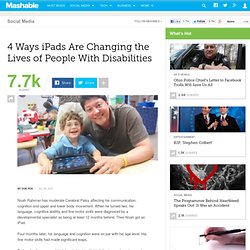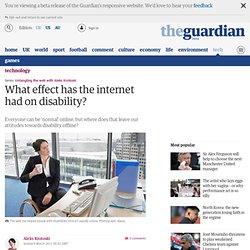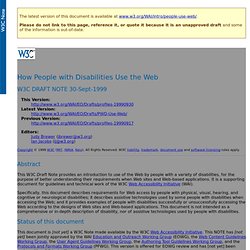

iModeling app: video modeling to teach skills to people with Austism Spectrum Disorder - iTunes App. 4 Ways iPads Are Helping People With Disabilities. Noah Rahman has moderate Cerebral Palsy affecting his communication, cognition and upper and lower body movement.

When he turned two, his language, cognitive abilitity and fine motor skills were diagnosed by a developmental specialist as being at least 12 months behind. Then Noah got an iPad. Four months later, his language and cognition were on par with his age level. His fine motor skills had made significant leaps. Today, the three-year-old (pictured at right with his father) spends an hour or two on his iPad each day. SNApps4Kids taps into a burgeoning trend for people with disabilities. "Touch has made it exceptionally accessible — everyone has an iPad, everyone has an iPod," says Michelle Diament, cofounder of Disability Scoop, a source for news relating to developmental disabilities. For people lacking motor skills, touch screens are more intuitive devices. Here are four ways that touch devices are changing the lives of people with disabilities: 1. 2. 3. 4.
40 Amazing iPad Apps for the Learning Disabled. The iPad is a device that many lust after as a shiny new toy, but many people with disabilities can benefit from what it has to offer as a functional tool.

Students with learning disabilities can enhance and develop their communication skills, learn how to adapt to situations, and develop social skills. Check out this collection of iPad apps that can make a difference in the life of a learning disabled child. Crazy Face Lite: Crazy Face Lite encourages shy students to speak more often, and is great with students who have trouble speaking.Autism Timer: This app offers a digital timer for students with autism.Behavior Assessment Pro: BAP identifies factors related to problem behaviors for autistic kids.Awareness!
100 Web Tools for Learning with a Disability. The Internet and the computers we use to access it are full of educational possibilities that can help to speed up, complement or provide endless opportunities to expand our knowledge.

Unfortunately, sometimes those with disabilities may find these resources more difficult or sometimes impossible to access. Internet Disability Resource Site. How disabled users access the Internet. In 1995 a new era of accessibility for disabled people began.

The DDA (Disability Discrimination Act) was passed, stating that: It's unlawful for a service provider to discriminate against a disabled person by refusing to provide any service which it provides to members of the public. A website is regarded as a service and the RNIB (Royal National Institute for the Blind) and DRC (Disability Rights Commission) have been quick to apply pressure on to organisations to push this law into practice. Indeed, the DRC has now published a report on its formal investigation into 1000 websites. So, how do disabled people access the Internet? Blind users Internet users who have no sight at all may utilize a screen reader, which reads the content of the web page, or rather the HTML code of the page, back to them. Partial/poor sight To take full advantage of the Internet, users with partial or poor sight may need to be able to enlarge the text on web pages.
Colour blindness Deaf users. What effect has the internet had on disability? There are more than 10 million people living in the UK with a long-term illness, impairment or disability according to the Office for Disability Issues (ODI) and although medical treatment and pre-birth screening have reduced this number dramatically over the last half-century, many of the problems faced by this population have not changed.

Compared with their non-disabled counterparts, people with disabilities in this country are still more likely to be poor and unemployed with fewer qualifications than non-disabled people, more likely to be the victims of crime and more likely to experience occupational and social discrimination. This was supposed to have been fixed by the web. After all, to put it crudely, there are no staircases online. In 2003, I started an MSc in social psychology, with all the wide-eyed expectations of a baby academic. I was going to prove that the web – and specifically online games such as EverQuest and World of Warcraft – could provide benefit to society.
Accessibility and Assistive Technology - Facebook Help Centre. Easy Chirp : web accessibility for the Twitter.com website application. How People with Disabilities Use the Web. Abstract This W3C Draft Note provides an introduction to use of the Web by people with a variety of disabilities, for the purpose of better understanding their requirements when Web sites and Web-based applications.

It is a supporting document for guidelines and technical work of the W3C Web Accessibility Initiative (WAI). Specifically, this document describes requirements for Web access by people with physical, visual, hearing, and cognitive or neurological disabilities; it describes assistive technologies used by some people with disabilities when accessing the Web; and it provides examples of people with disabilities successfully or unsuccessfully accessing the Web according to the designs of Web sites and Web-based applications. This document is not intended as a comprehensive or in-depth description of disability, nor of assistive technologies used by people with disabilities.
Status of this document Publication of a W3C Note does not imply endorsement by W3C membership. 1. Blindness. Disability Standards for Education 2005. Parent Advocacy Inc.